What are Secondary Keywords?
Secondary keywords, essential for SEO, complement the primary search term targeted on a page. They include synonyms, subtopics, and long-tail variations, helping to cover all facets of a topic and aiding Google in understanding page content.
Initially, primary keywords are identified during keyword research, such as “dress” for a dress-selling website.
Secondary keywords, like “sundress” or “maxi dress,” enhance the primary keyword, addressing nuances and subtopics of interest to the audience.
Using secondary keywords demonstrates a deeper understanding of the topic to Google, potentially improving rankings as the content satisfies user queries.
Group primary and secondary keywords in a single piece of content to avoid duplicate content issues.
Focus on the most popular term as the primary keyword and less popular variations as secondary keywords.
This strategy allows you to rank well for the primary keyword and one or multiple secondary keywords with a single webpage or article.
The Importance of Secondary Keywords in 2024
The importance of secondary keywords in SEO cannot be overstated. By focusing on these less competitive terms, you can accelerate your ranking process. Ranking for the primary keyword immediately is often unrealistic, but by targeting secondary keywords, you can start seeing results sooner. As you establish authority and rank for more secondary keywords, you’ll gradually increase your chances of ranking for primary keywords too.
Gain deeper insights into your audience. Secondary keywords play a crucial role in refining your SEO approach. As you begin ranking for these secondary terms, you gain valuable insights into your audience’s preferences and the types of terms that resonate with them. This information can then be leveraged to refine your targeting of primary keywords, enhancing the effectiveness of your SEO strategy.
Enhance the context of your content. Incorporating secondary search terms into your content makes your pages more relevant to user searches and aids search engines in comprehending the focus of your page.
Pro Tips for Researching Secondary Keywords
Finding secondary keywords is key to optimizing your content. These keywords are related to your primary keyword, so knowing your primary keyword is the first step.
Once you have that, finding secondary keywords becomes much easier.
Most secondary keywords can also be primary keywords, seed keywords, informational keywords, head keywords, or other types of keywords.
They’re versatile and can be used across different types of content.
To identify secondary keywords, start by understanding your primary keyword. Then, use these techniques to uncover secondary keywords that will enhance your content and improve your SEO.
Unlocking Keyword Potential: Viewing Your Product from Multiple Search Angles
When strategizing secondary keywords, it’s beneficial to approach your product or service from various perspectives to anticipate how people might search for it. For example, if you sell software, potential customers might search for “in-depth review of Clickup” or “Clickup vs. Jira.” If your SaaS tool is part of a larger network, creating content related to that network can attract a larger audience interested in your solution.
For instance, Zapier, an integration solution compatible with thousands of apps, produces content on various how-to guides that aren’t directly related to their brand. Similarly, Remotebase, an online developer recruitment platform, doesn’t limit itself to using “best online recruitment platform” as secondary keywords. Instead, they offer their audience career-related content, such as assistance in selecting their next tech role.
Furthermore, it’s crucial to consider the different stages of the customer journey. Individuals in the early research phase will have different search needs than those ready to make a purchase. Tailoring your keywords to each stage can enhance your visibility and relevance to potential customers.
Unlocking Secondary Keyword Ideas with Google’s Search Suggestions
Utilize Google’s search engine for keyword research by starting with a seed keyword and exploring the suggestions Google provides as you type. These suggestions are potential keywords to target. Additionally, leverage Google’s related searches feature by entering a seed keyword and reviewing the “Searches related to” section at the bottom of the search results page.
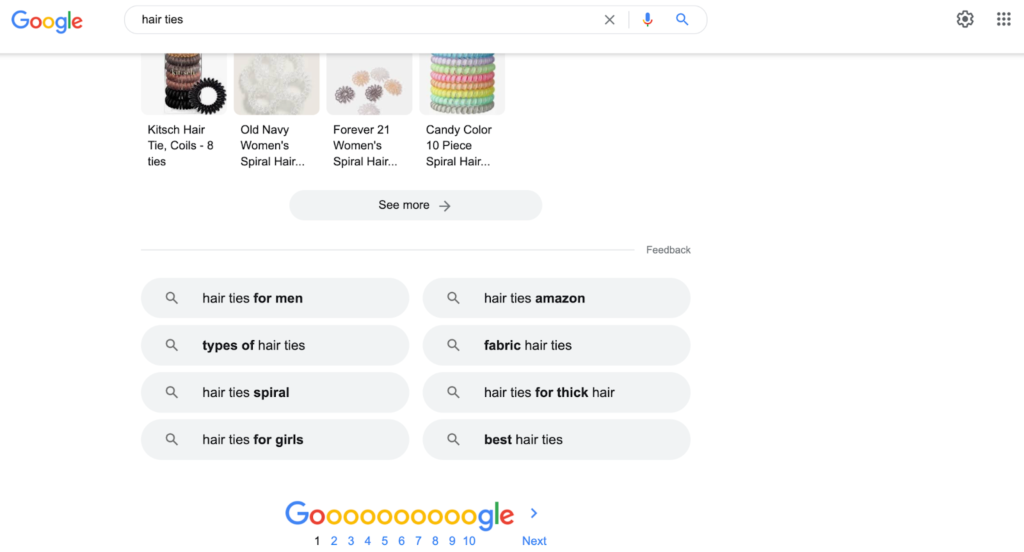
Furthermore, consider the “People Also Ask” section on the search results page, which provides leading questions (long-tail keywords) that customers are asking about the product. Incorporating these questions into your content can enhance your ranking potential.
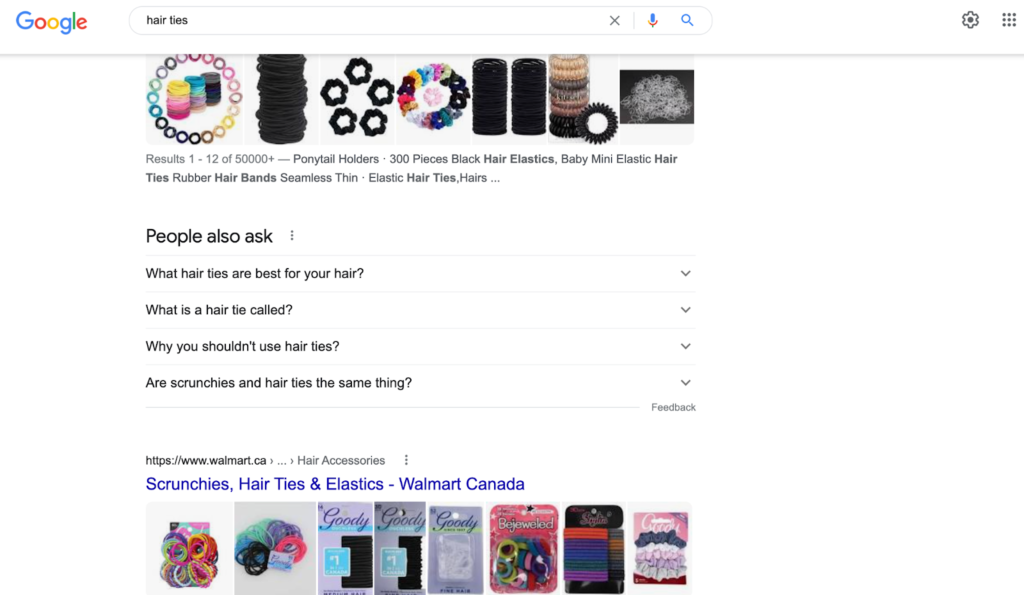
Check out your competition’s content
When seeking keyword ideas, researching your competition can provide valuable insights. By analyzing their targeted terms, you can gauge the competitiveness of certain keywords. Start with a Google search using keywords related to your business to see what your competitors are doing.
Tools like Ahrefs’ Site Explorer or SEMRush offer more detailed insights into your competition’s backlink profile and the keywords they’re ranking for. For instance, if you’re writing an article on “How to create an outline for a blog” and your focus keyword is “outline for a blog,” you can use Ahrefs to find relevant secondary keywords:
Log in to Ahrefs and click on Keywords Explorer.
Enter your primary keyword, such as “outline for a blog.”
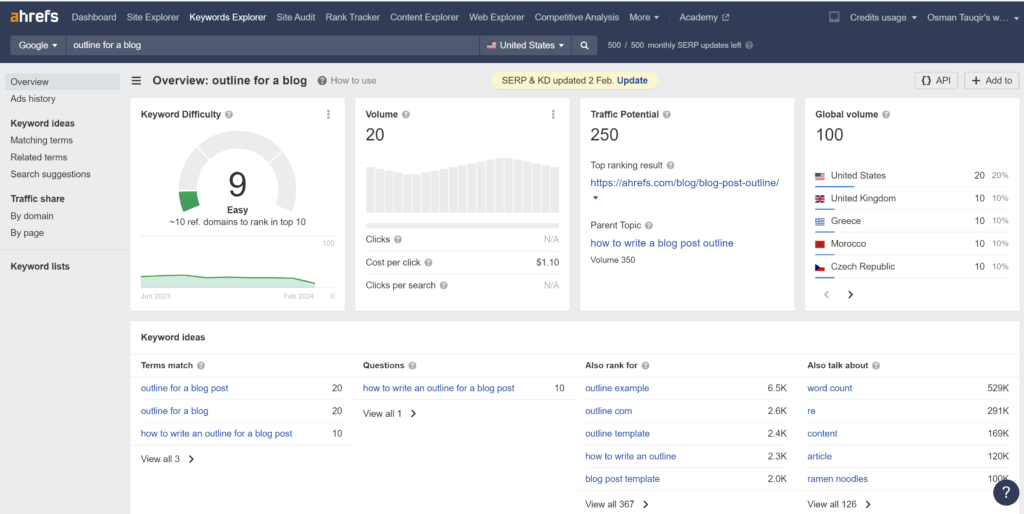
Review the SERP results at the bottom of the page to see the top 10 results.
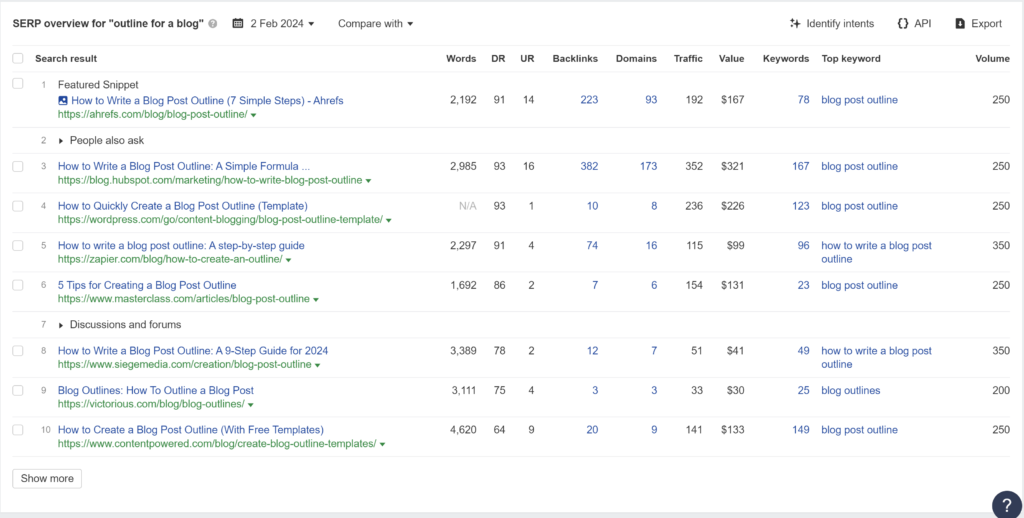
Click on “Keywords” for the top three SERP results.
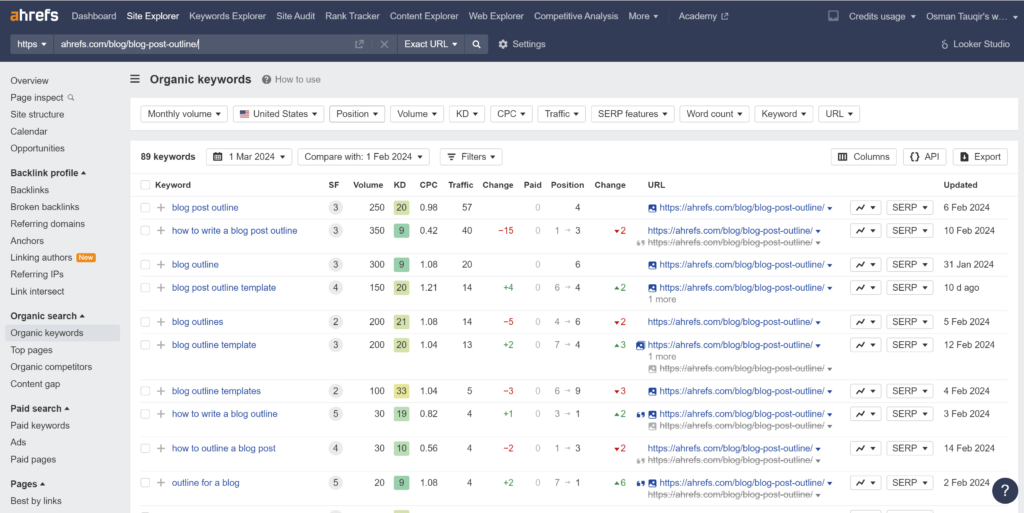
Assess the ranking keywords of the top three results to identify additional keywords for your article.
For new websites with lower domain reputation, target keywords with a Keyword Difficulty between 0-10 to increase your chances of ranking.
In the example above, simply add a Keyword Difficulty Filter of 0-10 and hit enter. You’ll be provided with a good list of low difficulty keywords that you’ll have a higher chance of ranking on Google SERPs.
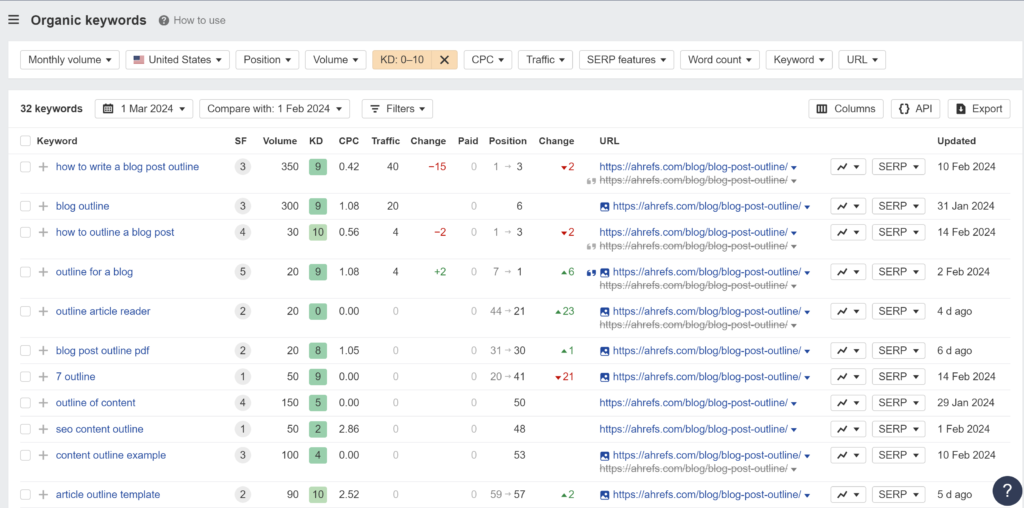
When to assess secondary keywords while working on already published content
When crafting content for clients, we rely on two key sources of information:
- Client Interviews: These provide crucial insights that drive our keyword research. By understanding the client’s pain points, we can target keywords that address real customer needs, attracting high-intent traffic that leads to conversions.
- SERP Analysis: Ensuring our content ranks well is essential. We analyze the current SERP for the target keyword to understand the competitive landscape. However, SERPs are dynamic, influenced by factors like new content, evolving search term interpretations, and Google algorithm updates. This dynamic nature may require us to “re-optimize” previously published content to remain competitive in the evolving SERP landscape.
Example Scenarios:
- Changing Target Audience: For instance, if the SERP shifts to a different user base, such as individuals tracking personal events instead of event tracking software, we would need to adapt our content to reflect this change.
- Changing Solution Types: Consider a scenario where new dedicated software for Dot Net Report tools emerges. This could lead to a change in the SERP, requiring us to update our content to remain relevant.
Re-optimization Strategy: We consider re-optimizing content if it ranks poorly (10th position or lower) for its target keyword and if the SERP has significantly changed since publication. This strategy ensures our content remains competitive and continues to attract organic traffic.
By following this approach, we identify secondary keywords that can enhance our content’s visibility and conversion rates. These secondary keywords often arise during the re-optimization process, as we discover new opportunities to refine our content for better performance.
In conclusion, integrating client-specific insights with thorough SERP analysis allows us to create content that not only resonates with the target audience but also ranks well in search results. This dual approach ensures that our content remains relevant, competitive, and effective in driving organic traffic and conversions.
Finding Secondary Keywords with High Buying-Intent
We noticed a drop in conversions for historically high-converting blog content that still ranked well for its target keyword. This led us to discover “secondary keywords,” which are keywords our posts ranked for indirectly. These secondary keywords were often semantically similar or related to our primary keyword.
For example, our blog post titled “25 Best Open Source Report Tools That You Have Never Heard About” was written to rank for the target keyword “open source report tools.” While it ranks for this keyword in position 6, it also ranks for around 143 other relevant keywords, most of which are semantically similar or variations of the main keyword. This post receives a good percentage of its traffic from these secondary keywords.
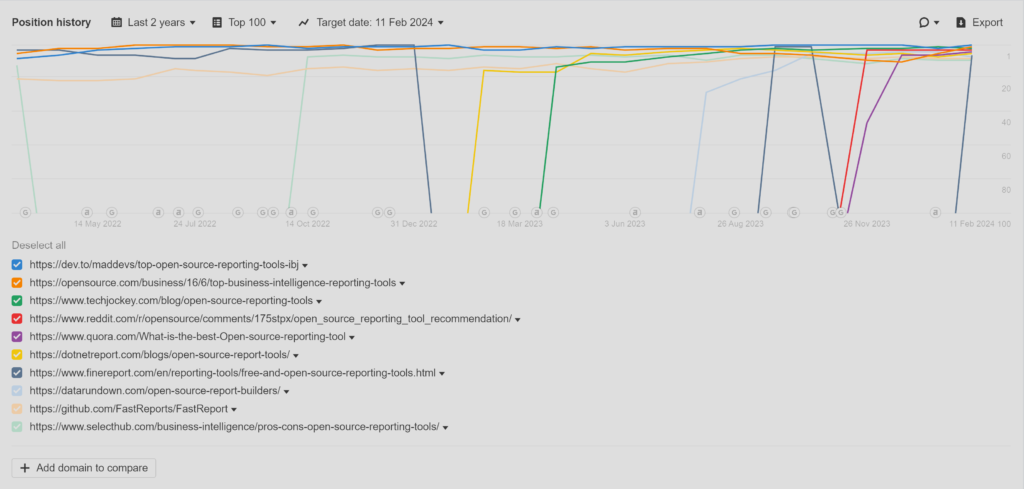
To find more opportunities to add to our list of keywords, we analyze the specific post’s performance in terms of traffic. By comparing the post’s performance on different dates, we can see what keywords were gained or lost over time.

When doing this research for clients, we first look at the best converting month for a specific post in the entire engagement. We then focus on high buying-intent keywords that bring in the most traffic.
Our content marketing strategy focuses on targeting high buying-intent keywords, whether they are long-tail or comparison keywords. Our goal is to increase conversions, so we prioritize keywords with high buying-intent and low search volume over those with low buying-intent and high search volume.
Exploring the Process of Re-optimizing Content for Secondary Keywords
Re-optimizing a blog post is like giving it a fresh coat of paint for better SEO performance. While the specifics vary based on the keyword targeted, the process generally involves two key aspects:
- Aligning with Search Intent: We ensure the post matches what users are looking for. This means tailoring content to match both primary and secondary keyword intent.
- On-Page Optimization: We fine-tune elements like titles, headings, meta descriptions, and keyword placement, avoiding common mistakes like keyword stuffing.
These steps help ensure our content remains relevant and competitive in the ever-evolving landscape of search engine algorithms!”
Secondary keywords vs LSI (semantic) keywords: Understanding the difference
When it comes to SEO, understanding the difference between semantic and secondary keywords is key.
Semantic keywords, like “social media” or “SEO,” are related to your primary keyword but aren’t meant for ranking. They enrich your content’s context.
On the other hand, secondary keywords, such as “digital marketing strategies” or “digital marketing tips,” are chosen to closely align with your primary keyword and are intended for ranking. They’re part of your target keyword group.
Maximizing the Impact of Secondary Keywords
Utilizing secondary keywords effectively can significantly enhance your content’s impact. To achieve this, follow these guidelines:
- Avoid keyword stuffing to maintain a natural flow and prevent turning off readers.
- Limit the number of secondary keywords to five to avoid overcrowding your content.
- Where possible, overlap primary and secondary keywords to improve coherence.
- Use internal links to reinforce primary and secondary keywords, signalling their importance to search engines.
- Incorporate secondary keywords into H2 tags to strengthen their impact.
In Conclusion
Keywords are crucial for SEO and content relevance. While primary keywords take the spotlight, integrating secondary keywords strategically can help you outshine competitors and attract the right audience, ultimately boosting your revenue.












